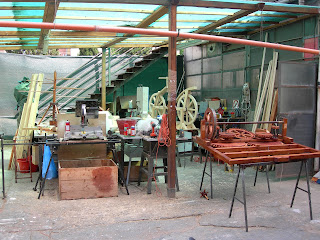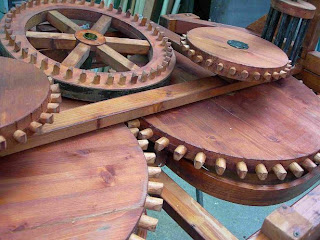Tutto è nato da una passione giovanile di Carlo Niccolai per la meccanica il
quale, frequentando la scuola Leonardo da Vinci di Firenze ha avuto occasione di restaurare, assieme
ai professori responsabili, la collezione interna di macchine vinciane.
Niccolai Carlo, seguendo le tradizioni dell’artigiano fiorentino, ha trasmesso la passione ai figli e ai nipoti, i quali, grazie anche alla conoscenza delle nuove tecnologie, hanno potuto ampliare la collezione e realizzare oltre cento esposizioni in tutto il mondo negli ultimi dieci anni.
La fedele ricostruzione dei modelli è stata apprezzata dal professor Carlo Pedretti, Direttore del Centro “Armand Hammer” di Studi su Leonardo presso L’università della California a Los Angeles e della sua Sede Europea presso l’Università di Urbino. Il supporto culturale del Professor Pedretti nella collaborazione in questi anni è stato prezioso per il riconoscimento internazionale e il perfezionamento dei modelli riprodotti.
Negli ultimi anni si è affiancato allo studio di ricerca una vera e propria equipe formata da studiosi storici, ingegneri, architetti e artigiani,che hanno contribuito ha perfezionare la ricerca storica e quella scientifica.
ipotesi sul Leone Meccanico.La collezione oltre che essere disponibile per musei o grandi mostre, può essere noleggiata anche per piccoli eventi come piccole esposizioni per scuole, conferenze, cene rinascimentali ecc.
THE
NICCOLAI COLLECTION
For Carlo Niccolai, everything is born of a youthful
passion for the mechanics, as going to school he was given the opportunity
to work with teachers to restore items from the Leonardo da Vinci
collection of internal machinery.
This early experience allowed him
to start building machines in the family workshop in 1952, testing and verfying
operations until in 1961, Carlo’s knowledge was expanded when he
bought some books on the mechanics of Leonardo da Vinci.
Over the years, Carlo was happy creating his own collection of Leonardo da Vinci scale models, however in 1994 the family business underwent a major upheaval. Carlo’s
son Gabriel joined him and together they transformed Carlo’s passion into a
productive family business.
By 1996 Carlo and Gabriele had created 30 models and wishing to share these creations
with the public, they exhibited some at the Sala del Carmine in Florence,
Piazza del Carmine and some at the renowned Leonardo da Vinci museum in Vinci.
Many of the models exhibited were subsequently purchased by collectors and the
museums for permanent display.Following the success of these early public
displays, in 1999, Gabriel commenced working of his first solo exhibition,
with 30 models which were more suited to museum displays.
Some of the model were interactive, allowing the
public to experience their workings and understand the functions. This
was very different from the traditional ways of Museum display and the public
thoroughly enjoyed it.The collection was exhibited for the first time in Elba
on Capoliveri Island and was then taken in October to the exhibition halls
of the church of San Lorenzo in Florence.
Since then, year after year, model after model has
witnessed the creation of the largest, private collection of
Leonardo da Vinci machines, worldwide.Over the years the collection has grown
so much that is has surpassed collections in various museums around the world,
reaching more than 170 models built separately, using materials of the time of
Leonardo da Vinci - wood, metal, rope and cloth.
Not surprising, is that there have been many unpublished findings
and discoveries resulting from the production of this fine collection as
it’s the first time for many of the Da Vinci mechanics to be tested and
verified.Following the Florentine Artisan tradition, Carlo Niccolai handed down
to his children and grandchildren, his passion and craftmanship who then, with
up to date knowledge and enhanced technology, expanded the collection of
da Vinci machines to create over one hundred exhibitions world-wide, over the
past ten years.
The accuracy and faithful reconstruction of these
models has been acknowledged and appreciated by Professor Carlo Pedretti,
Director of the Center “Armand Hammer” of Leonardo Studies at the University of
California, Los Angeles (UCLA) and its European headquarters at the University
of Urbino. Professor Pedretti supports cultural cooperation and in recent years
has been invaluable to the international recognition and improvement of models
in the collection.In recent years he has supported and refined the development
of of team consisting of historical scholars, engineers, architects and
craftsmen working in the fields of scientific and historical research.
The collection has been enhanced by research of Vitruvian
machines, greek-roman machines and of ‘ancient Egyptian’ machines, leading into
new studies not only on the technology of medieval renaissance, but studies
that look back to ancient technologies.
The research center also carries out research on
behalf of third parties and has the rediscovery Leonardo and the new automaton
hypotheses Leone Meccanico.
The collection is available for museums or
exhibitions and can also be rented for small events such as small exhibitions
for schools, conferences, dinners etc.
 |
 |
 |
 |
 |
 |
 |
 |
 |
 |
 |
 |
 |
 |
 |
 |
 |
 |
 |
 |
 |
 |
 |
 |
 |
 |
 |
 |
 |
 |
 |
 |
 |
 |
 |
 |
 |
 |
 |
 |
 |
 |
 |
 |
 |
 |
 |
 |
 |
 |
 |
 |
 |
 |
 |
 |
 |
 |
 |
 |
 |
 |
 |
 |
 |
 |
 |
 |
 |
 |
 |
 |
 |
 |
 |
 |
 |


Nessun commento:
Posta un commento